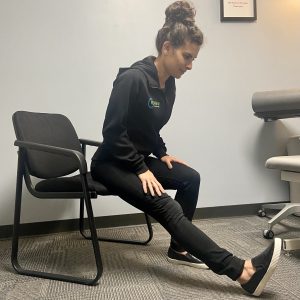Working at a desk job often requires you to sit for extended periods of time, which can lead to poor posture and various bodily aches and pains. During the pandemic, many office workers transitioned to working from a home office full-time or drastically cutting down on days spent in their company’s office building. This change of workplace structure also meant a change to a few key elements of a typical day. While the freedom of working from home comes with some perks (hello sweatpants), the effects it has had on physical health are staggering. Let’s break down how these changes are leading to more physical ailments and ways you can easily work to combat them.
- No More Commute: Walking to another room in your house does not equal the walk to/from a parking garage, bus stop, or train station. These small bouts of movement can be enough to keep our body’s metabolism, circulation, and energy supplies stimulated and active.
- Makeshift Home Offices: If we must work off a computer/desk, then an ergonomically designed setup is best. Going from a sleek office chair to the kitchen table fundamentally changes our posture, placing increased stress and discomfort on our lower backs, hips, shoulders, and necks.
- Less Defined Working Hours: When our office is our home, work hours can start earlier and end later, leading to an overall increase in time spent at our workstations.
- Less Convenient Forms of Exercise: When we don’t commute to work, we don’t drive by our regular gym, or end work in time for an exercise class, or walk to grab lunch. Creating time for your favorite type of movement can be more difficult when it is not a part of your regular workday.
So, what can we do to help ourselves? Luckily, some very minor tweaks can dramatically improve our overall health.
- Set a Timer: Taking a stretch break every 20-30 minutes can help to reset our attention to our posture, circulate our blood, and activate our muscles. Here are a few examples of basic stretches that can be done at your desk:
- Spinal Twist: By twisting at your torso, the supporting muscles along your spine elongate and help to open tight shoulders.
- Standing Side Stretch: Stretching your obliques, shoulders, and arms helps to increase spinal mobility.
- Neck Rolls: Slowly rolling your neck relaxes your neck muscles and can help with any discomfort and stiffness associated with neck strain.
- Hamstring Stretch: Sitting at your desk every day can cause tightening in your hamstrings and reduce your range of motion. This exercise helps to increase blood circulation and reduce muscle fatigue.
- Wrist Flexor Stretch: Flexing your wrists when you’re typing, driving, or holding a phone can lead to achy, painful wrists and elbows. This gentle stretch can help ease the pain and decrease your risk of developing carpal tunnel or elbow pain.
- Strive to Stand More: We should ideally try to stand for the majority of our workday, but even building to standing 50% of the time can have benefits for our bones, heart health, brain function, and metabolism.
- Set an Exercise Schedule: Plan to walk around the block each Wednesday at lunch, do a 10-minute HIIT online class each Thursday morning, schedule a phone meeting during a time you can be outside. Finding ways to move that are enjoyable and fit into your day will increase the likelihood that you will follow through!
- Educate Yourself: Sometimes information is the key to motivation! Juststand.org is a great resource full of statistics and research that can help to improve your standing/movement time.
If you suffer from persisting pain, or just need help building a strategic plan around getting more movement in your day, the highly skilled therapists at Renew can get you on your way to a more active lifestyle!



